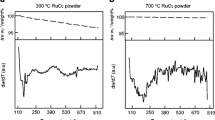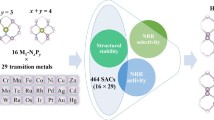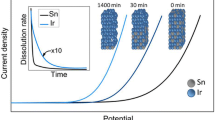Abstract
Solid-state ionic conductor is a vital part in all electrochemical energy conversion devices. As a widely-applied proton-conducting polymer and stabilizer for electrode preparation, Nafion has key applications in electrochemical devices operated under acidic conditions. Specific adsorption of Nafion on the catalyst surface is considered to result in partial loss of intrinsic activity in reactions such as oxygen reduction reaction (ORR), due to its comprehensive occupation of active sites. Many in situ characterization methods such as voltammetric fingerprinting and spectroscopic approaches have been used to explore the dynamic adsorption of Nafion on the electrode surface. However, most of current efforts have been focused on the behaviors of Nafion itself, with little attention paid to its effects on the adsorption of surface intermediates. Here, we employed the in situ electrical transport spectroscopy (ETS) to investigate Nafion adsorption on Pt catalysts and its effects on the ORR intermediates. Our findings suggest that specific adsorption of Nafion results in the increased coverage of oxygen intermediates with weaker adsorption strength, which in turn plays a critical role in the reaction selectivity. The successful application of ETS on the dynamic characterization of reaction intermediates provides a novel perspective for catalyst design in ORR-related applications in future sustainable chemistry.

Similar content being viewed by others
References
Kusoglu A, Weber AZ. Chem Rev, 2017, 117: 987–1104
Kim YS, Lee KS. Polym Rev, 2015, 55: 330–370
Tucker MC, Cho KT, Spingler FB, Weber AZ, Lin G. J Power Sources, 2015, 284: 212–221
Perry ML, Weber AZ. J Electrochem Soc, 2016, 163: A5064–A5067
Xiang C, Weber AZ, Ardo S, Berger A, Chen YK, Coridan R, Fountaine KT, Haussener S, Hu S, Liu R, Lewis NS, Modestino MA, Shaner MM, Singh MR, Stevens JC, Sun K, Walczak K. Angew Chem Int Ed, 2016, 55: 12974–12988
Kongkanand A, Mathias MF. J Phys Chem Lett, 2016, 7: 1127–1137
Holdcroft S. Chem Mater, 2014, 26: 381–393
Subbaraman R, Strmcnik D, Paulikas AP, Stamenkovic VR, Markovic NM. ChemPhysChem, 2010, 11: 2825–2833
Kodama K, Motobayashi K, Shinohara A, Hasegawa N, Kudo K, Jinnouchi R, Osawa M, Morimoto Y. ACS Catal, 2018, 8: 694–700
Li Y, Intikhab S, Malkani A, Xu B, Snyder J. ACS Catal, 2020, 10: 7691–7698
Subbaraman R, Strmcnik D, Stamenkovic V, Markovic NM. J Phys Chem C, 2010, 114: 8414–8422
Sarapuu A, Hussain S, Kasikov A, Pollet BG, Tammeveski K. J Electroanal Chem, 2019, 848: 113292
Kunimatsu K, Yoda T, Tryk DA, Uchida H, Watanabe M. Phys Chem Chem Phys, 2010, 12: 621–629
Hanawa H, Kunimatsu K, Watanabe M, Uchida H. J Phys Chem C, 2012, 116: 21401–21406
Zeng J, Jean D, Ji C, Zou S. Langmuir, 2012, 28: 957–964
Yagi I, Inokuma K, Kimijima K, Notsu H. J Phys Chem C, 2014, 118: 26182–26190
Ding M, He Q, Wang G, Cheng HC, Huang Y, Duan X. Nat Commun, 2015, 6: 7867
Ding M, Zhong G, Zhao Z, Huang Z, Li M, Shiu HY, Liu Y, Shakir I, Huang Y, Duan X. ACS Cent Sci, 2018, 4: 590–599
Mu Z, Yang M, He W, Pan Y, Zhang P, Li X, Wu X, Ding M. J Phys Chem Lett, 2020, 11: 5798–5806
Tian B, Shin H, Liu S, Fei M, Mu Z, Liu C, Pan Y, Sun Y, Goddard III WA, Ding M. Angew Chem Int Ed, 2021, 60: 16448–16456
Liu S, Wang C, Wu J, Tian B, Sun Y, Lv Y, Mu Z, Sun Y, Li X, Wang F, Wang Y, Tang L, Wang P, Li Y, Ding M. ACS Catal, 2021, 11: 12476–12484
He W, Zang H, Cai S, Mu Z, Liu C, Ding M, Wang P, Wang X. Nano Res, 2020, 13: 2917–2924
Pan Y, Wang X, Zhang W, Tang L, Mu Z, Liu C, Tian B, Fei M, Sun Y, Su H, Gao L, Wang P, Duan X, Ma J, Ding M. Nat Commun, 2022, 13: 3063
Angerstein-Kozlowska H, Conway BE, Sharp WBA. J Electroanal Chem Interfacial Electrochem, 1973, 43: 9–36
Conway BE, Gottesfeld S. J Chem Soc Faraday Trans 1, 1973, 69: 1090–1107
Tilak BV, Conway BE, Angerstein-Kozlowska H. J Electroanal Chem Interfacial Electrochem, 1973, 48: 1–23
Dong JC, Zhang XG, Briega-Martos V, Jin X, Yang J, Chen S, Yang ZL, Wu DY, Feliu JM, Williams CT, Tian ZQ, Li JF. Nat Energy, 2019, 4: 60–67
Dong JC, Su M, Briega-Martos V, Li L, Le JB, Radjenovic P, Zhou XS, Feliu JM, Tian ZQ, Li JF. J Am Chem Soc, 2020, 142: 715–719
Katsounaros I, Schneider WB, Meier JC, Benedikt U, Biedermann PU, Auer AA, Mayrhofer KJJ. Phys Chem Chem Phys, 2012, 14: 7384–7391
Yu TH, Sha Y, Liu WG, Merinov BV, Shirvanian P, Goddard III WA. J Am Chem Soc, 2011, 133: 19857–19863
Luo M, Koper MTM. Nat Catal, 2022, 5: 615–623
Xia C, Kim JY, Wang H. Nat Catal, 2020, 3: 605–607
Ding Y, Zhou W, Xie L, Chen S, Gao J, Sun F, Zhao G, Qin Y. Mater Chem A, 2021, 9: 15948–15954
Yuan Q, Zhao J, Mok DH, Zheng Z, Ye Y, Liang C, Zhou L, Back S, Jiang K. Nano Lett, 2022, 22: 1257–1264
Strasser P, Koh S, Anniyev T, Greeley J, More K, Yu C, Liu Z, Kaya S, Nordlund D, Ogasawara H, Toney MF, Nilsson A. Nat Chem, 2010, 2: 454–460
Stephens IEL, Bondarenko AS, Perez-Alonso FJ, Calle-Vallejo F, Bech L, Johansson TP, Jepsen AK, Frydendal R, Knudsen BP, Rossmeisl J, Chorkendorff I. J Am Chem Soc, 2011, 133: 5485–5491
Chen J, Finfrock YZ, Wang Z, Sham TK. Sci Rep, 2021, 11: 13698
Tymoczko J, Calle-Vallejo F, Colic V, Koper MTM, Schuhmann W, Bandarenka AS. ACS Catal, 2014, 4: 3772–3778
Tymoczko J, Schuhmann W, Bandarenka AS. ChemElectroChem, 2014, 1: 213–219
Stephens IEL, Bondarenko AS, Grønbjerg U, Rossmeisl J, Chorkendorff I. Energy Environ Sci, 2012, 5: 6744–6762
Acknowledgements
This work was supported by the Natural Science Foundation of China (22172075 and 92156024), the Fundamental Research Funds for the Central Universities in China (14380273), Natural Science Foundation of Jiangsu Province (BK20220069), Beijing National Laboratory for Molecular Sciences (BNLMS202107), and the Thousand Talents Plan of Jiangxi Province (jxsq2019102002).
Author information
Authors and Affiliations
Corresponding author
Ethics declarations
Conflict of interest The authors declare no conflict of interest.
Additional information
Supporting information The supporting information is available online at https://chem.scichina.com and https://link.springer.com/journal/11426. The supporting materials are published as submitted, without typesetting or editing. The responsibility for scientific accuracy and content remains entirely with the authors.
Supporting information
11426_2022_1428_MOESM1_ESM.pdf
Unravelling the critical role of surface Nafion adsorption in Pt-catalyzed oxygen reduction reaction by in situ electrical transport spectroscopy
Rights and permissions
About this article
Cite this article
Sun, Y., Tian, J., Mu, Z. et al. Unravelling the critical role of surface Nafion adsorption in Pt-catalyzed oxygen reduction reaction by in situ electrical transport spectroscopy. Sci. China Chem. 65, 2290–2298 (2022). https://doi.org/10.1007/s11426-022-1428-6
Received:
Accepted:
Published:
Issue Date:
DOI: https://doi.org/10.1007/s11426-022-1428-6




